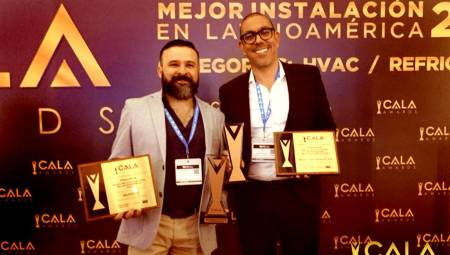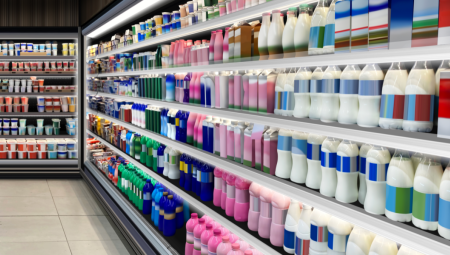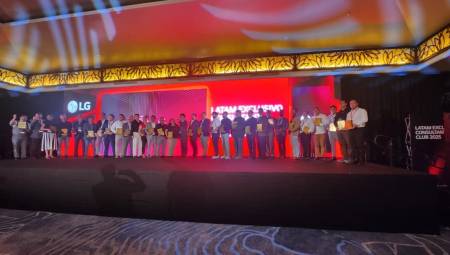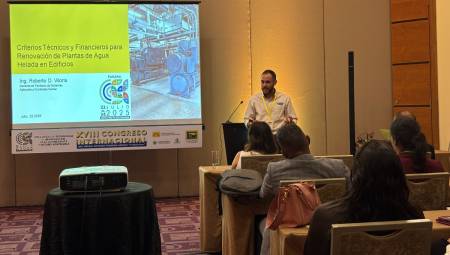by Iván Darío Quintero
In its constant displacement with all its contents, the air enters the ducts of the air conditioning systems of the buildings; there, they could be circulating, with the indoor air current, hair, skin scales and cosmetics. Both currents could mix and enter the interior of the building loaded with contaminants and many of these particles, some with more than five microns, would undoubtedly end up on objects, people or food.
Fortunately this does not have to be the case, because air conditioning systems can have powerful filtering units that in facilities of rigorous indoor air quality can guarantee more than 99.97% disinfection.
However, to achieve excellent indoor air quality not only filters are necessary, there is a large number of equipment and maintenance programs that contribute to the cleaning and disinfection of air conditioning systems, robots that allow video verification of the state of ducts, lights and ultraviolet lamps with high germicidal power and management of critical control points, among other interesting devices.
But if you want a good system with optimal conditions for health, where the air has a high level of purity and disinfection, you will have to be especially careful with the filtering unit.
A filtering unit can guarantee a healthy indoor air quality, with high purity in some cases and free of thousands of bacteria in others, providing comfortable spaces for work, shopping or housing and eliminating possible diseases in a high percentage.
The figures that motivate the efforts of specialists to look for options to purify indoor air could be summarized in the statistics presented by the World Health Organization, which estimated in 2006, that 4.6 million people died a year from causes that could be attributed to air pollution.
The constant search for methods and devices to purify the air has given rise to filters of many kinds and qualities, the common ones are not the best and the best ones are not common because they are expensive, but in the same way you can design filtering units with excellent efficiency indexes and low cost.
Only centralized systems?
Not all air conditioning systems have the same power, nor the same ability to filter the air, systems such as mini splits and VRV / VRF, although economical and with great temperature control capacity, are not the best options when it comes to indoor air quality.
According to Celso S. Alexandre, CEO of the Brazilian company Trox Technik, mini split and VRV/VRF equipment are not recommended at all if you are looking for indoor air quality. The engineer highlighted as the main impediment in these equipment the low static pressure available, a factor that forces the filters of these mechanisms to be of very low efficiency, precisely so that the pressure loss is very little. In Alexandre's more metaphorical words, "the filters of these systems are good for birds, but not for particles less than five microns."
These devices do not have space to receive F5 filters according to ISO requirements, in addition, the mini split and VRV/ VRF do not have the capacity to offer good humidity control and cannot withstand the requirements of required outdoor air flows.
Split systems could be used with more demanding filtrations, but different variables would have to be taken into account, according to engineer Jorge L. Velasco, general manager of Air Quaslity Mexico, it would be necessary to look at these systems to feed what is necessary outside air and that they are designed with enough space to place the filter package, the engineer also clarified that in the split systems that are installed, to generate moderate air quality conditions, the designer plays a fundamental role and must take special care.
If in the mini split or VRV/VRF systems high efficiency filters should not be installed and in the split ones large filter batteries cannot be handled, the only possibility left to implement air conditioning systems, which provide rigorous indoor air quality, are the centralized systems, where a complete filtering area can be placed. {mospagebreak}
MERV
The filtering units are installed currently adjacent to the area where the outside air mixes with the indoor air in the centralized air conditioning systems, this, with the aim that all the air passes through the filtering process.
Filtering units are usually composed of an initial part of pre-filtering and subsequently of a final filtration zone. It is proceeded in this way so that in the pre-filtering area all the large particles remain and only the smallest ones reach the filtering part. In the same way, the filters of the pre-filtering area serve to take care of the filters of the final part, which due to their greater filtration capacity are more expensive.
The construction of filtering units has become a science, since filters are available on the market in a wide variety of materials, capacities and shapes. The proper implementation and combination of filters in the pre-filtering and filtering areas are determinants of the level of efficiency reached by the system.
To determine and verify the efficiency of filters, MERV, Minimum Efficiency Reporting Value, or minimum efficiency report value have been accepted internationally as a standard.
Most filters are labeled with the MERV number they obtain in the evaluation, this indicates the efficiency of the filter to trap particles, and the smaller the ones it stops, the higher the MERV rating number.
According to the MERV and the annotations of engineer Velasco, the filters can be divided into four large groups: filters with low, medium, high and absolute efficiency.
The MERV exams give the low-efficiency group grades from one to four, the medium from five to eight and the high-level from nine to 15, and from then on there is talk of absolute efficiency filters.
Among the main characteristics of the filters of low RATING MERV, it is found that generally these filters are washable and that they do not reach 20% efficiency, stopping only particles between three and 10 microns, they are usually used for paint booths, the best known within this range are the filters of polyester rolls and the filters panels of fiberglass.
The medium MERV rating filters, ranging from five to eight, have efficiencies of 20% to 65%, within this category are almost all pleated filters that are the most used in air conditioning, and that are on the market with thicknesses ranging from one to four inches.
The high category receive MERV rating between nine and 15, these guarantee between 85% and 95% of minimum efficiency when capturing the particles. This category is the one that has the widest range of products on the market. Some of the best known filters are those of bag, and the rigid ones, the latter can be built of plastic, metal, cardboard or wood. We can also mention here the box type, and the miniplisados.
The filters of the absolute category are superior to the rating 15 and guarantee detection efficiencies not minimum at 99.97%. The best known filters in this category are HEPA (High Efficiency Particulate Air), and ULPA (Ultra Low Penetration Air). These filters can stop microparticles of 0.3 um and 0.12 um, respectively and are developed under strict regulations, since their operation must be guaranteed throughout their time of use. Due to their high degree of efficiency, they are commonly used in hospital units and places of rigorous indoor air quality. {mospagebreak}
Filter maintenance
In the filtering units, combinations of filters are made with the aim of establishing the maximum point of air purification according to the needs of the client and the care that you want to give to the most expensive filters. MeRV low rating filters are usually put in front and high or absolute rating filters behind.
Basically, the maintenance of the filtration unit is reduced to washing the filters in the pre-filtering area and periodically changing the high filters, in the final filtration zone.
Maintenance in the filtering units is basic, even the highest quality filter will not be able to perform its job correctly if it is covered with a thick layer of particles from the pre-filtered air. The intervals for changing filters vary depending on the filter type; however, the engineer Velasco believes that it is not possible to say how often a filter should be changed, because a filter in a green area is not the same as in a desert, the most advisable, according to him, is to use pressure gauges that report on the pressure differential to determine periods of useful life for the filter and develop a replacement calendar, this for the industrial sector or large facilities.
Already in home installations, it is advisable to change the filters once a month. New homes, as well as homes where some remodeling or construction is taking place, need more frequent filter changes to compensate for extra dust and debris in the air.
When you are going to buy a filter it is important to take into account, according to the recommendations of the engineer Velasco, that the construction is good, that the filter is well sealed, that the product is of quality, observe in detail how many square feet of filter surface it has, in the same way observe the initial and final pressure drop, this information must come in the technical data of the tables given by the manufacturers. The idea is to compare tables and make the most appropriate decision.
Filters and energy saving
Filters are a very important component in saving energy in air conditioning equipment, according to Velasco, studies have revealed that in a normal industry where there are no blast furnaces, with a good maintenance system of air conditioning equipment and a good filtration system, air conditioning generates more or less 80% of the total energy consumption of the entire plant, this in summer or hot seasons. But in case proper maintenance and regular change of filters is not carried out, air conditioning equipment can generate up to 30 or 35% more energy consumption.
The successive filter batteries in the filtering units raise the levels of resistance to the passage of air, forcing the use of fans that guarantee the flow of air through each filtration station, coil, section; until it is delivered, through the network of air distribution ducts, at the supply points with the required levels, which ostensibly increases energy consumption.
An appropriate combination of filters can help reduce that inconvenience and save between 10 and 20% of energy, so the Quality Air manager sees with very good eyes the intervention of a qualified advisor in this process, because it can happen that two filters provide the same efficiency, but one filter can consume twice as much energy as the other, so you have to select the filters and their combinations taking into account different conditions: the type of equipment, the initial drop and the space for the filter in the system, among other external aspects such as dust levels in the installation area.
If it is not chosen correctly, it may happen that more energy is spent than it deals with, for example: taking into account the indoor air quality needs of the end user, it may happen that a filter with a MERV 15 rating is not needed but instead, given the requirements, a MERV 12 or up to MERV 8 can be installed, then energy is saved in the application, since the ventilation units will not have to strain to pass the air through such a rigorous filter.
Undoubtedly, there is enough fabric to cut with the issue of filters as key components to determine indoor air quality levels, in this approach we highlight the fundamental role played by filtering units in central air conditioning systems, both to guarantee air quality as well as to contribute to energy savings.













